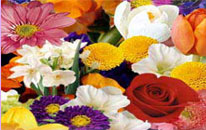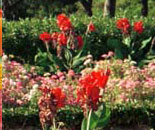India's flower business
Delhi may have the maximum ‘flower traffic’ in Asia. The city is the convergence point of dealers in flowers. Traders in most cities have contacts with dealers in Delhi and not with dealers in cities where the flowers actually originate. For instance, flowers from distant Bangalore arrive in Delhi and are then transported to Bhopal. Orchids are imported from Thailand and then exported to Singapore. Despite the growth and sale of flowers having spread over most of the country, India's annual flower production stands at around 1,000 tonnes and the country's floriculture industry has a miniscule 0.01 per cent share in the international market.
Quite a few flower varieties come from Pune and Bangalore - two cities, which boast of the maximum number of greenhouses mainly because of their ideally temperate climes. These include the ubiquitous rose, carnations, and bird of paradise. Lucky bamboos are imported from Thailand, like Orchids. The merry marigold comes from Kolkata. Gladioli converge at Delhi from all over the country, while Bangalore and Thailand again are hometown for lilies. Romantic rajnigandhas originate in Muzaffarnagar while tulips abound in the hills of Shimla and Kullu.
And what does Delhi have to offer, you wonder!
“Delhi has only population and pollution. Yet, flower sellers all over India are dependant on Delhi’s location and networks with other cities and countries for selling their flowers. The problems faced by flower sellers in Delhi are typically faced by those in our business all over India. In fact, growers in remote areas have even more pronounced problems of transportation, packaging and storage as these services are even less developed in rural areas,” offers Praveen Pratap Singh, a wholesaler who sells flowers grown in his farm at Muzaffarnagar.
Flower demand in Delhi itself is seasonal and the market has enormous fluctuations. As Pandey puts it, "Bika to phool nahin to dhool". (If it sells it's a flower, otherwise it is dust). A bunch of gerbera, which sells for Rs. 80 in peak season, costs only Rs. 2 when the season is lean. The (Hindu) marriage season between October and February as also the months of April, May and June are roaring business at the flower market.
International perspective
According to a report of the International Labour Organisation (ILO) - ‘The world cut flower industry: Trends and prospects’ by Gijsbert van Liemt, China and India dominate in terms of area under cultivation but their yield per hectare is low. “In India and China, purchasing power is too low for sizeable imports to take place and quality is too low for sizeable exports to develop”.
Germany is the typical example of a second group of countries with sizeable markets where imports satisfy most demand (up to 70 per cent). Roses are the main traded product and Germany is the largest import market, followed by the United States. A third group, which includes Columbia and Kenya, have a small home market but a large volume of exports. Lastly, The Netherlands is a member of the group with a large home market combined with a large export share. It is the world's leading exporter.
The developed countries have a competitive advantage in their being close to the market and to quality research and extension services. They have room for innovation and boast of high quality physical infrastructure. However, high labour costs are a competitive disadvantage. Developing countries benefit from low cost of manual labour, but skilled labour and technicians can be expensive. They also have abundant light, good climatic conditions and low land costs. However, airfreight adds significantly to the total cost of exports.
Quality is the catchword as far as exports as concerned. Quality benchmarking of flowers has many aspects. For instance, flowers should be free from plagues and diseases and they should be undamaged – elements, which can be judged on visual inspection. Other quality aspects, however, are more difficult to judge. For instance, it is hard to see whether flowers have been correctly handled once cut. Yet this is an important determinant of vase life and whether or not the bud will open. This is why reputation is so important and why growers who have consistently delivered high quality flowers fetch higher prices than little known or irregular suppliers.
While a majority of Indian flowers blooming in the fields are certainly at par in quality to the ones grown in Europe, the problem begins the moment they're cut and commence their journey to the market. Improper handling after harvest, unavailability of optimum temperature and moisture conditions during storage and transportation, under or over-packaging leading to damage and wiltering are a few factors which have an adverse impact on the quality of Indian flowers reaching the consumer - both domestic and international.


